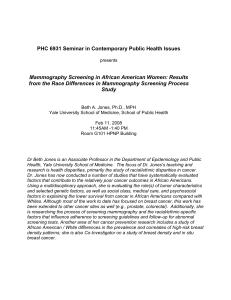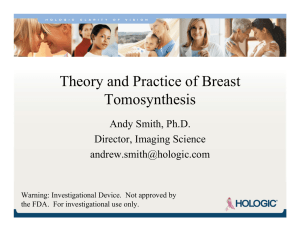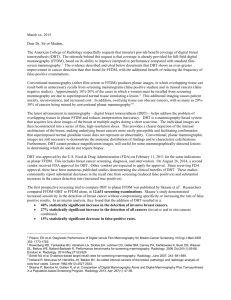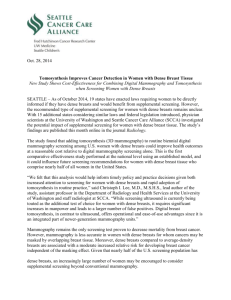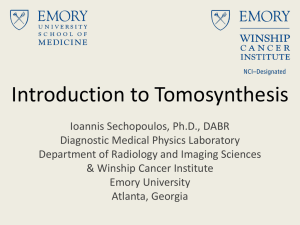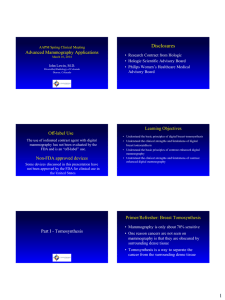Linda Greer, MD Medical Director 3/14/2013
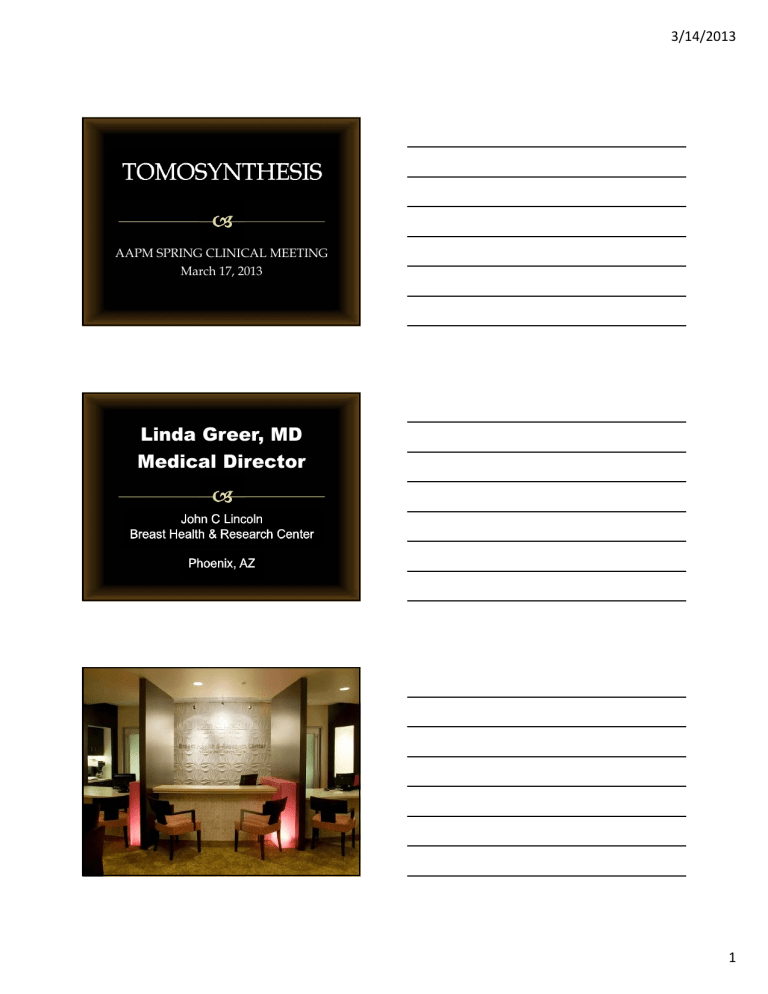
AAPM SPRING CLINICAL MEETING
March 17, 2013
Linda Greer, MD
Medical Director
3/14/2013
1
EXPERIENCE
Opened May 2009
Grew from 60 pts/day to 80 pts/day by early
2011
TOMO FDA APPROVED February 2011
Installed tomo April 2011…2 clinically nd site in US to use
Grew rapidly to about 100-120 pts/day
To date have done over 22,000 tomo cases
Why Tomosynthesis?
•
A major factor contributing to the limited performance of mammography is the tissue superimposition that is created by the overlap of normal breast structures in a twodimensional mammographic projection.
• These overlapping structures can obscure a lesion making it more difficult to perceive or rendering it completely mammographically occult.
Selenia Dimensions
6
3/14/2013
2
3D Principle of Operation
Arc of motion of x-ray tube, showing individual exposures
• X ‐ ray tube moves in an arc across the breast
• A series of low dose images are acquired from different angles
• Total dose approximately the same as one 2D mammogram
• Projection images are reconstructed into
1 mm slices
Reconstructed
Slices
{
Compression
Paddle
Compressed
Breast
Detector Housing
TOMOSYNTHESIS
Same compression as 2D mammogram
Same positioning as 2D mammogram
Arm sweeps over the breast, taking 15 images (4 sec acquisition)….those then reconstructed into the 3D image set
Viewed as 1mm thick “slices”
Number of slices determined by breast thickness
3/14/2013
3
IMPLEMENTATION
Started by offering to women with dense to moderately dense breasts AND to women requesting tomo
Wait times excessive
Added 2 nd tomo unit in September 2011
3 rd unit ordered for satellite office
Why Dense Breasts
• Initially thought only significant benefit to dense breasts
• Later discovered benefit for fatty breasts as well
PROTOCOL
SCREENING:
-Combo mode (FDA mandated)
-3D set obtained first, 2D set last
-Same compression and positioning as 2D
-CC and MLO views….some lesions still seen better or only on one view
3/14/2013
4
PROTOCOL
DIAGNOSTIC:
-Can use as needed…2D screening will get tomo only call back
-Tomo screening: usually DO NOT do spot compression images…go straight to US for mass or distortion
(SPOT TOMO…using for areas where compression might not be optimal)
-Still do spot mag for calcifications
RADIATION DOSE
• Radiation dose is similar to film screen mammography (COMBO MODE)
• – 2D~ 1.2
mGy
• – 3D~1.45
mGy
• – Combo ~2.65
mGy
• – Screen/Film (ACRIN) ~2.0
mGy average
**** based on ACR phantom****
3/14/2013
5
C VIEW
-3D image set is obtained, with a 2D image reconstructed from that data set
-This will effectively decrease radiation dose by 50%
-Used for guide in viewing the 3D image set and for comparison to old mammograms
-ACCENTUATES distortions and calcifications
-Does NOT accentuate smooth masses
*C-view Synthesized 2D Image
~60 Tomosynthesis Slices
How does it work?
Perform a standard tomosynthesis scan
(existing system)
Reconstruct tomosynthesis slices
(existing system)
Reconstruction
Algorithm
15 Projection Images
*Not approved for sale in the United States
C-view Synthesized 2D Image
~60 Tomosynthesis Slices
How does it work?
Perform a standard tomosynthesis scan (existing system)
Reconstruct tomosynthesis slices (existing system)
Synthesize 2D image (C-View)
Similar to Maximum
Intensity Projection (MIP) as done with MRI images
Image Summation
C-View
*Not approved for sale in the United States
3/14/2013
6
3/14/2013
*Not approved for sale in the United States
*Not approved for sale in the United States
CALCIFICATIONS with
C-VIEW
examples
7
3/14/2013
2D FFDM
2D FFDM C ‐ View
2D FFDM C ‐ View 3D Slice
8
3/14/2013
2D FFDM
2D FFDM C ‐ View
9
3/14/2013
2D FFDM
10
2D FFDM C ‐ View example
3/14/2013
11
3/14/2013
RCC
2D FFDM
12
RCC
2D FFDM
RCC
2D FFDM
RCC
3/14/2013
13
2D FFDM
RCC
RCC
3/14/2013
14
3/14/2013
2D FFDM
8/15 readers recalled
2D FFDM mean POM: 14.4%
(probability of malignancy)
2D FFDM C ‐ View Tomosynthesis
15
3/14/2013
2D FFDM C ‐ View Tomosynthesis
13/15 readers recalled
2D FFDM C ‐ View Tomosynthesis mean POM: 60.1%
Rationale for 3D plus *C-View
• The advantage of two-view tomosynthesis while reducing dose and capitalizing on the benefits of 3D
• Value of a 2-dimensional “summary” image:
— Assessment of side to side symmetry
— Assessment of interval change
— Detection of calcifications
— Recognition of the distributional aspect of features
(particularly calcifications)
*Not approved for sale in the United States
16
CASES
Routine screening
3/14/2013
17
54
LOGES
52 © 2012. ICPME All rights reserved.
53 © 2012. ICPME All rights reserved.
3/14/2013
18
Routine screening
3/14/2013
19
SUPERIMPOSED TISSUE
These cases illustrate one of the greatest benefits of tomosynthesis: the
ELIMINATION OF
SUPERIMPOSED NORMAL
TISSUES
Routine screening
3/14/2013
20
ross
61 © 2012. ICPME All rights reserved.
62 © 2012. ICPME All rights reserved.
63 © 2012. ICPME All rights reserved.
3/14/2013
21
64 © 2012. ICPME All rights reserved.
65 © 2012. ICPME All rights reserved.
66 © 2012. ICPME All rights reserved.
3/14/2013
22
67 © 2012. ICPME All rights reserved.
TOMO ONLY CA
This case illustrates the ability of tomo, by eliminating superimposed tissues, to show a small cancer NOT VISIBLE on the 2D mammogram
The cancer is also not seen on additional spot compression images…so we now RARELY do spot compression views
Routine screening
3/14/2013
23
3/14/2013
24
MULTIFOCAL IDC
This case illustrates how the 1mm slice allows visualization of distortion MUCH BETTER, even in a relatively fatty breast
This allows more accurate and complete workups
3/14/2013
25
Routine screening
3/14/2013
26
3/14/2013
27
INVASIVE DUCTAL CA
This is another case of cancer seen ONLY WITH
TOMO, and in this case, really only well seen on the MLO TOMO VIEW
On our screen, a scrollbar displays the slice number and indicates position, so even if only seen on one view, it can still be localized
Routine screening
3/14/2013
28
3/14/2013
29
RADIAL SCAR
Because this was a distortion with linear calcifications extending anteriorly, excision was done, showing no evidence of malignancy.
3/14/2013
30
MISCELLANEOUS
mole mole
3/14/2013
31
Fat necrosis
Lumpectomy scar
3/14/2013
32
Skin calcs
Lymph node
Sebaceous cyst
3/14/2013
33
OSLO STUDY
The Oslo Tomosynthesis Screening
Trial (Dr Skaane)
12,631 patients…compared 2D alone to 2D +3D over a 13 month period
OSLO STUDY FINDINGS
40% increase in detection of invasive cancers
27% increase in detection of ALL cancers (invasive and in situ)
3/14/2013
34
TOMO BENEFITS
Decrease mammo call backs (decreased by 40%at our site)
-Ultrasound call back unchanged (fewer call backs for superimposed tissues, but are finding more REAL lesions
-Increase PPV (increased by about 35%)
-BR3 decreased by 2% for entire practice
MORE BENEFITS
Better able to determine multifocality
Often can see an associated mass (with calcs), which might be occult on
2D...prompting search with ultrasound for invasive component
3/14/2013
35
OTHER BENEFITS
Stopped using mole markers and nipple markers
Stopped having to work up skin calcs, moles, vascular calcs
Can localize even when only seen on one view (using the scrollbar)…less time wasted searching with additional images
SUMMARY
What that MEANS is that each callback has a MUCH HIGHER probability of being REAL….must be more diligent with callbacks as we KNOW we should find something with ultrasound
3/14/2013
36
SUMMARY
Fewer mammo callbacks = schedule freed up for more screenings and for more
“necessary” workups
Techs spend much less time searching for a lesion with the smaller spot compression paddle
? Less radiation dose for the population
FINAL SUMMARY
I think the major strength of 3D is for screening…increased confidence in BR1 and
BR2, better detection of subtle distortion, small masses
Increased confidence that a callback will be an actionable finding
THANKS
FOR YOUR
ATTENTION
3/14/2013
37
0%
0%
0%
0%
0%
The
radiation
dose
for
combo
mode
(2D
plus
3D)
is:
1.
1.45
mGy
2.
2.65
mGy
3.
4.85
mGy
4.
8.85
mGy
5.
10.65
mGy
10
ANSWER
2.65
mGy
http://www.fda.gov/downloads/AdvisoryCommittees
/CommitteesMeetingMaterials/MedicalDevices/Medi calDevicesAdvisoryCommittee/RadiologicalDevicesPa nel/UCM226757.pdf
113
0%
0%
0%
0%
0%
One
of
the
major
benefits
of
3D
imaging
is:
1.
Lower radiation dose per case
2.
Better visualization of calcifications
3.
Less compression
4.
Elimination of superimposed normal tissues
5.
Easier positioning
10
3/14/2013
38
ANSWER
Elimination
of
superimposed
normal
tissues
Kopans.
Breast Imaging, 3 rd edition.
Lippincott Williams and Wilkins
115
The one thing that C ‐ View would NOT be helpful for would be:
0%
0%
0%
0%
0%
1.
Decreased radiation dose by about 50%
2.
Better visualization of smooth/benign masses
3.
Accentuation of distortions and calcifications
4.
Comparison to prior 2D exams
5.
Guide for viewing the 3D image set
10
ANSWER
Better
visualization
of
smooth/benign
masses
http://www.fda.gov/downloads/AdvisoryCommittees/CommitteesM eetingMaterials/MedicalDevices/MedicalDevicesAdvisoryCommittee
/RadiologicalDevicesPanel/UCM325901.pdf
117
3/14/2013
39
The major findings of the Oslo study regarding 2D imaging vs 2D plus 3D imaging for screening were :
0%
0%
0%
1.
There were no advantages to including 3D imaging in their population
0%
2.
There was a 40% increase in the invasive cancer detection rate
0% 3.
The detection rate for noninvasive cancers fell by
10%
4.
3D imaging was only helpful in denser breasts
5.
The call back rate for additional imaging increased, due to better visualization, by 25%
10
ANSWER
There
was
a
40%
increase
in
the
invasive
cancer
detection
rate
• Comparison of Digital Mammography Alone and Digital Mammography Plus
Tomosynthesis in a Population ‐ based Screening Program.
Skaane P, Bandos AI,
Gullien R, et al.
Radiology, 2013 Jan 7.
[Epub ahead of print]
119
What is the one thing we have NOT FOUND since tomosynthesis was introduced:
0%
0%
0%
0%
0%
1.
Decreased call back rate for additional mammographic imaging by about 40%
2.
More BR3 (probably benign) results
3.
Increased cancer detection rate (40% for invasive cancers, by Oslo study)
4.
Stable call back rate for ultrasound examinations
5.
Increased positive predictive value for biopsies of about 35%
10
3/14/2013
40
ANSWER
More
BR3
(probably
benign)
results
• Rose S, Bujnoch L, O’Toole M, Nordmann A, Sexton R, Willison K, Tidwell A.
Breast Tomosynthesis and Digital Mammography for Breast Cancer Screening:
Medical Outcomes Audit.
Presented at RSNA 2012, VSBR41 ‐ 06 Breast Series:
Emerging Technologies in Breast Imaging
• Comparison of Digital Mammography Alone and Digital Mammography Plus
Tomosynthesis in a Population ‐ based Screening Program.
Skaane P, Bandos AI,
Gullien R, et al.
Radiology, 2013 Jan 7.
[Epub ahead of print]
121
3/14/2013
41


